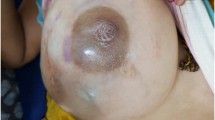Abstract
Thrombolytic therapy (TT) is now established as the main treatment of acute myocardial infarction (MI). Spontaneous breast hematoma, usually a rare complication of anticoagulant therapy, has been described in the last five decades, but not after thrombolytic therapy. We present three patients who developed the rare complication of breast hematoma after TT, out of 495 women treated with TT in ICCU in our hospital, because of acute MI in the last 12 years. One patient needed blood transfusion and in another patient, atypical ductal nuclei were observed in fine needle aspiration (FNA) of breast hematoma, needing further evaluation. As thrombolytic therapy becomes more wide-spread and essential in treating patients suffering acute occlusion of coronary, retinal, pulmonary or peripheral arteries, it is expected that more women will present with breast hematoma following such treatment.
Similar content being viewed by others
References
Rosen PP (1997) Hemorrhagic necrosis and anticoagulant therapy. In: Rosen's breast pathology. New York: Lippincott Raven, p 24.
Caldwell EH, Stewart S (1983) Skin necrosis as a consequence of coumadin therapy. Plast Reconstruct Surg 72:231–233.
Ceriani R, Cavalli P, Perone C (1985) Complicanze chirurgiche della therapia anticoagulante. Minerva chirurgica 40:1361–1364.
Kahn S, Stern HD, Rhodes GA (1971) Cutaneous and subcutaneous necrosis as a complication of coumarin-congener therapy. Plast Reconstruct Surg 48:160–166.
Stricker H, Lammle B, Furlan M, Sulzer I (1988) Heparin-dependent in vitro aggregation of normal platelets by plasma of a patient with heparin-induced skin necrosis: Specific diagnostic test for a rare side effect. Am J Med 1988;85:721–724.
Flood PF, Redish MH, Bociek SJ, Shapiro S (1943) Thrombophlebitis migrans disseminata. Report of a case in which gangrene of the breast occurred. NY State J Med 43:1121–1124.
Andersson I, Adler DD, Ljungberg O (1987) Breast necrosis associated with thrombolic disorders. Acta Radiol 28:517–521.
Davis CE, Wileg WB, Faulconer RJ (1972) Necrosis of the female breast complicating oral anticoagulant treatment. Ann Surg 175:647–656.
Hermann G, Schwartz I, Slater G (1986) Breast mass in a 69-year-old woman. JAMA 255:939–940.
Martin BF, Phillips JD (1970) Gangrene of the female breast with anticoagulant therapy: A report of two cases. Am J Clin Pathol 53:622–626.
Mason JR (1970) Hemorrhage-induced breast gangrene. Br J Surg 57:700–702.
McCrea ES (1981) Hemorrhage into the breast. J Can Assoc Radiol 32:62–63.
Nudelman HL, Kempson RL (1966) Necrosis of the breast: A rare complication of anticoagulant therapy. Am J Surg 111:728–733.
Romanucci D, Jakovic LG, Smedberg K (1974) Anticoagulants and hemorrhage-breast necrosis: A case report. Angiology 25:612–616.
Rick ME (1990) Protein C and protein S. JAMA 263:701–703.
Bonk U (1971) (Acute hemorrhagic breast necrosis under an anticoagulation treatment). Dtsch Gesundheitsw 26:355–359.
Tong D (1971) Hemorrhagic necrosis of the breast complicating anticoagulant therapy and mitral stenosis. Br J Surg 58:624–628.
Leor J, Livschitz S, Vered Z (1990) Giant breast hematoma requiring blood transfusion: An unusual complication after an echocardiographic study during thrombolytic therapy. J Am Soc Echocardiogram 3:502–504.
Shrotria S, Ghilchik MW (1994) Breast hematomas: Same appearance, different diagnosis. Br J Clin Pract 48:214–215.
Constantini V, Zacharski RL, Memoli VA, Kudryk BJ, Rousseau SM, Stump DC (1991) Occurrence of components of fibrinolysis pathways in situ in neoplastic and nonneoplastic human breast tissue. Cancer Res 51:354–358.
Zacharski LR, Wojtukiewicz MZ, Constantini V, Ornstein DL, Memoli A (1992) Pathways of coagulation/fibrinolysis activation in malignancy. Semin Thromb Hemost 18:104–116.
Duffy MJ, Reilly D, O'Sullivan C, O'Higgins N, Fennelly JJ, Andreasen P (1990) Urokinase-plasminogen activator, a new prognostic marker in breast cancer. Cancer Res 50:6827–6829.
Foekens JA, Schmitt M, Van-Putten WL, Peters HA, Bontenbal M, Janicke F, Klijn JG (1992) Prognostic value of urokinase-type plasminogen activator in 671 primary breast cancer patients. Cancer Res 52:6101–6105.
Gandolfo GM, Canti L, Vercillo M (1996) Fibrinolysis components as prognostic markers in breast cancer and colorectal carcinoma. Anticancer Res 16:2155–2159.
Caffney PJ, Cooke DA, Burnand KG (1994) Urokinase and its receptors: Marker of malignancy? Adv Exp Med Biol 360:187–191.
Duffy MJ, O'Grady P, Devaney D, O'Siorain L, Fennelly JJ, Lijnen HJ (1988) Urokinase-plasminogen activator, a marker for aggressive breast carcinoma. Preliminary report. Cancer 62:513–533.
Janicke F, Pache L, Schmitt M, Ulm K, Thomssen C, Prechtl A, Graef57H (1994) Both the cytosols and detergent extracts of breast cancer tissues are suited to evaluate the prognostic impact of the urokinase-type plasminogen activator and its inhibitor, plasminogen activator type 1. Cancer Res 54:2527–2530.
Schmitt M, Janicke F, Graeff H (1990) Tumor associated fibrinolysis: The prognostic relevance of plasminogen activators μPA and tPA in human breast cancer. Blood Coagul Fibrinolysis 1:695–702.
Author information
Authors and Affiliations
Additional information
Presented in part at the 40th Annual World Congress, International College of Angiology, Lisbon, Portugal, July 1998.
About this article
Cite this article
Yahalom, M., Roguin, N., Bickel, A. et al. Breast hematoma complicating thrombolytic therapy. International Journal of Angiology 9, 74–77 (2000). https://doi.org/10.1007/BF01617044
Issue Date:
DOI: https://doi.org/10.1007/BF01617044




